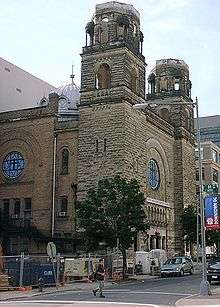Washington Hebrew Congregation
| Washington Hebrew Congregation | |
|---|---|
 Site of Washington Hebrew Congregation's building, 1898-1954, | |
| Basic information | |
| Location |
|
| Affiliation | Reform Judaism |
| Website |
www |
Washington Hebrew Congregation is a Jewish congregation in Washington, D.C.
History
Washington Hebrew Congregation was formed on April 25, 1852, in Washington, D.C., by twenty-one members.
Solomon Pribram was elected the first president. By 1854, there were forty-two members. On December 13, 1855, at the thirty-fourth session of the United States Congress, a special act was passed, which provided that
| “ | all the rights, privileges, and immunities heretofore granted by the law to the Christian churches in the city of Washington be and the same hereby are extended to the Hebrew Congregation of said city. | ” |
The congregation grew steadily in membership and in influence; in 1863 it moved to the site of a former Methodist church, which had been used by the government as a hospital during the Civil War.
From 1897 to 1954, the congregation met at 816 Eighth Street NW, in a building designed by Washington architects Louis F. Stutz and Frank W. Pease.[1] The cornerstone of this building was laid on September 16, 1897, by President William McKinley. This building was sold to New Hope Baptist Church (later Greater New Hope Baptist Church) in March 1954.[2]
In 1952, President Harry S. Truman laid the cornerstone of the congregation's current home on Macomb Street NW, which was dedicated on May 6, 1955, by President Dwight D. Eisenhower.
By 1905, the First Washington Hebrew Congregation was the only Reform congregation in the District of Columbia, with a membership of 350, and a religious school attended by 200 children.
One prominent leader was Uriah P. Levy, the first Jewish Commodore of the United States Navy.
Adas Israel Congregation, with Isaac Stampel as Hazzan, was founded in 1869 by 69 members of the Washington Hebrew Congregation who objected to the Reform tendencies of the old congregation.
In the summer of 1966, a group of young Jewish activists urged the synagogue's rabbi, Rabbi Norman Gerstenfeld, to denounce a white Jewish landlord named Allie Freed for engaging in racist housing practices against African-Americans. After Rabbi Gerstenfeld refused to denounce Freed, Jewish members of ACCESS (Action Coordinating Committee to End Segregation in the Suburbs) leafleted the congregation during Yom Kippur in 1966 and 1967. They were condemned by Jason R. Silverman of the Anti-Defamation League of B'nai B'rith for protesting on Yom Kippur. In light of this, Jewish activists founded Jews for Urban Justice in order to campaign against anti-black racism within white Jewish communities.[3]
Washington Hebrew Congregation is currently a member of the Union for Reform Judaism. It is one of the largest Reform congregations in the United States,[4] with 2,781 members reported on the Union for Reform Judaism database as of 2012.[5]
References
- ↑ Washington Hebrew Congregation Building Committee minutes, November 29, 1896, cited in Justin M. Spivey, "The Washington Hebrew Temple", typescript, Historical Society of Washington, D.C., 1997.
- ↑ "Greater New Hope Baptist Climaxes 20th Anniversary," Washington Afro-American, June 21, 1958.
- ↑ "Guide to the Jews for Urban Justice (Washington, D.C.) Records, 1967-1971". Center for Jewish History. Retrieved 2018-08-29.
- ↑ "Expansive chuppah: Washington Hebrew OKs officiation of interfaith weddings - with conditions", Washington Jewish Week, September 6, 2006 (as of 2006, Washington Hebrew was 3rd largest Reform congregation).
- ↑ Congregational Profile of Stephen S. Wise Temple, Union for Reform Judaism (accessed February 13, 2012).
![]()
- Jewish Encyclopedia article on Washington D.C. congregations
- Raphael, Marc Lee. Towards a "national shrine": a centennial history of Washington Hebrew Congregation 1855-1955 (Williamsburg, Va.: Dept. of Religious Studies, College of William and Mary, 2005); no ISBN.